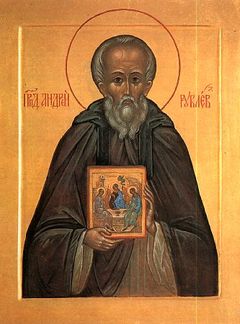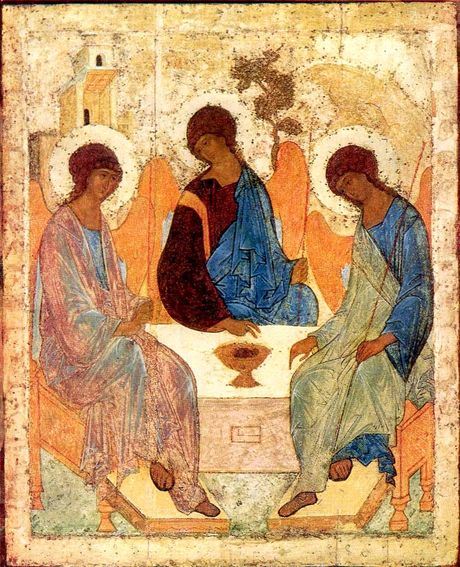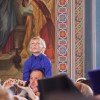Source: www.frederica.com
 The Psalmist writes, “Worship the Lord in the beauty of holiness,” words that fall on deaf ears in a culture that knows as little of beauty as of holiness. Look at new church construction. So many contemporary churches do not aim to be beautiful; they aim to be functional. This might still work out all right, if the designers truly thought the function of a church is worship, but too often the assumed function is communication with the people in attendance, either to teach, uplift, or entertain them. Contemporary worship spaces look more like education spaces or entertainment spaces than like sanctuaries. By contrast, picture a church constructed with an eye to beauty, designed to draw us into the presence of God. It is fitting that it be beautiful, because beauty opens our hearts.
The Psalmist writes, “Worship the Lord in the beauty of holiness,” words that fall on deaf ears in a culture that knows as little of beauty as of holiness. Look at new church construction. So many contemporary churches do not aim to be beautiful; they aim to be functional. This might still work out all right, if the designers truly thought the function of a church is worship, but too often the assumed function is communication with the people in attendance, either to teach, uplift, or entertain them. Contemporary worship spaces look more like education spaces or entertainment spaces than like sanctuaries. By contrast, picture a church constructed with an eye to beauty, designed to draw us into the presence of God. It is fitting that it be beautiful, because beauty opens our hearts.
Of course it is not obvious to all that beauty always leads us to God. I once was interviewed by a reporter for National Public Radio, who questioned this point of view. She asked, “Doesn’t all the music and painting and artwork in your church distract you from focusing on God?” and I responded, “Tell me this. If your husband takes you out for an anniversary dinner, and there is candlelight and roses and violins, does that distract you from feeling romantic?”
That’s how humans are made, to respond to beauty with openness and joy-a truth more apparent to earlier Christians than to many of us today. And just as we delight in the presence of friends, so we might imagine a traditional church in which our joy is heightened by seeing the faces of our friends above us and around us: Christ, angels, and saints through history. My husband went on a mission team to Romania last year, and saw historic churches in which paintings cover every surface, walls and ceiling, inside and out, with images from Scripture and the lives of the saints. Such a sight is an overwhelming experience, but in fact, it is the truth. These images aren’t just history-book reminders. In truth, we are surrounded by a great cloud of witnesses. When we worship, they are invisibly alongside us, “in every place lifting holy hands” (I Tim 2:8). When we look around and see these friends surrounding us it is as if for a moment the veil is lifted, and we see what a great company of believers we are.
But there are some things you won’t see depicted in churches. There is an important safeguard in the tradition of Christian sacred art that keeps us from falling over into idolatry. It’s that we don’t make images of things that God has not shown us. You can make a painting of Christ, because he was born and walked on this earth; this human likeness is something God has deliberately chosen to show us, and it would be fearful superstition, if not Gnosticism, to forbid making paintings of Christ.
But you won’t see a picture of God the Father as an old man with a beard. God hasn’t shown us that. As a rule, you won’t see a painting of the Trinity; instead, the Trinity is symbolized geometrically, by a triangle or triquetra.
There is one point in Scripture, however, when God is revealed in three persons simultaneously, and sometimes that event is depicted as a representation of the Trinity. Not the baptism of Jesus; there we see Jesus, and the Holy Spirit as a dove, but only hear the voice of God. When do we see all three visibly? “The Lord appeared to [Abraham] by the oaks of Mamre, as he sat at the door of his tent in the heat of the day. He lifted up his eyes and looked, and behold, three men stood in front of him.” (Gen 18:1-2).
The painting reproduced on the cover of this issue is titled “The Old Testament Trinity,” and it is probably the best-known and most-admired icon among Western Christians. It was painted by Andrei Rublev, a Russian monk, in 1411. He is honored as one of the most gifted icon painters, and you may have seen a film biography of him that came out a few years ago. (If you did, maybe you can explain it to me, because I couldn’t make heads or tails of it.)
Though most icons are anonymous, and usually the name of the painter is forgotten, those by Rublev have continued to bear his name, because of his unusual gift. He painted with lightness, clarity, and an ethereal touch that few could equal. There is nothing sentimental about his painting, but instead a great sense of freshness. After the death of the abbot of his monastery, St. Sergius of Radonezh, Rublev painted this icon to hang over Sergius’ tomb.
This is not the only presentation of the Old Testament Trinity in the art of Eastern Christianity. Sometimes we see Abraham and Sarah in the background, holding platters of food; in that case, the title is “The Hospitality of Abraham.” This style, of the three figures alone, is often used on the Feast of Pentecost.
Note a few of the details in the image besides the commanding figures. We can see in the background the oak of Mamre; the Holy Land is such a treeless place that a stand of oaks would be a well-known landmark. The three figures sit around a stone table that early Christians would have recognized as an altar. The niche in the front represents a tomb; not only the empty tomb of Christ, but also the Christian custom from the time of the catacombs of placing the bones of departed believers beneath their altars. On the table is a gold chalice containing red wine mixed with bread. This is how Eastern Orthodox prepare the Eucharist, by combining leavened bread and wine in the same chalice and receiving from a spoon.
As we look at this icon, can we tell which of the three is the Father, which the Son, and which the Holy Spirit? Theologians would warn us against it; distinguishing the three into separate bodies suggests division, rather than the unity of the Trinity. It would be safer, perhaps, to understand that all three together somehow represent the Trinity.
And Genesis, it is true, doesn’t encourage us to fix too closely on distinctions between the “three men.” “They” speak to Abraham, but later it is “the LORD” who is speaking. “The men” depart, but “Abraham still stood before the LORD.” When the company arrives in the city of Sodom it is no longer “three men,” nor “the LORD,” but now “two angels.”
Whatever is going on here, it’s complicated, and Scripture doesn’t give us enough information to sort it all out. But this much we can rely on: the three men, or angels, who appear to Abraham and Sarah are a visitation from the LORD: God has appeared to them in the form of three persons.

As I look at this icon, though, I suspect that Rublev did intend for us to recognize the three different members of the Trinity. The Father is on the left. His robe is iridescent, shifting from glowing golden-red to azure blue, a triumph of the painter’s art. “You robe yourself in light as in a garment” (Ps 104:2).
The Son and the Holy Spirit both gaze toward him, inclining their heads. There is an expression of deference, which is reflected in the version of the Nicene Creed that Rublev would have recited daily: the Son is begotten of the Father, the Spirit proceeds from the Father. If we imagine this theology of the Trinity represented as a triangle, the point is clearly on the top. The father is the “arche,” the source; both Son and Spirit originate in Him.
Not to get too deeply into the minutiae of history, but it was of course a change in Western European Christianity about the turn of the millennium that first suggested adding the term “filioque” to the Nicene Creed, a dispute that eventually led to the Great Schism between Christians east and west. The original Creed, written in the fourth century, said that the Spirit proceeds from the Father; Western Christians wanted to add the word “filioque,” “and the Son.” At a time when the divinity of the Son was being challenged, it seemed an appropriate safeguard to proclaim that the Son is the source of the Spirit as well. And it seemed Scripturally accurate. After all, “[Jesus] breathed on them and said to them, ‘Receive the Holy Spirit’” (John 20:22).
But this confuses the immediate transmission of the Spirit to humans in this world, performed in this case by Jesus breathing upon his disciples, with the question of the eternal origin of the Spirit. At the beginning, the Spirit proceeds from the Father. Later, Jesus says he will ask the Father to send us the Spirit, and he then breathes on his disciples to impart it. But, like the Son, the origin of the Spirit from before all time remains with the Father alone.
What do such words even mean? What does it mean that the Son is “begotten,” and the Spirit “proceeds”? I am not competent to tackle such questions. “Such knowledge is too wonderful for me; it is high, I cannot attain it” (Ps 139:5). And when I read over the orders I received when I became a Christian, it doesn’t look like I need to know the answer to this question. I just need to do my job as an ordinary believer, following his path and helping others along the way. It looks like prying into the deep things of God is not included in my marching orders. The one thing I can know is that the Father is the ultimate source, as we see here. Both Son and Spirit incline their heads to him.
The Son, in the middle, is wearing a robe of deep purple-red; this is the purple of royalty, rather than the lavender or so-called “royal purple” we think of today. Purple fabric was very expensive; remember Lydia in the book of Acts (Acts 16:14), who dealt in purple goods. It sounds strange today to think of dealing in items based solely on their color, although I did once see a kiosk at the mall titled “All Things Purple,” and it was. (I wondered whether the proprietor’s name was Lydia.) Today purple dye is produced as cheaply as other colors, but in ancient times the source was a tiny gland at the back of the head of the murex snail. Only the wealthiest could afford it, hence the association with royalty. Over his purple tunic the Son wears a blue mantle, indicating divinity. Both Father and Spirit wear their blues as a tunic.
I should note that when we look at ancient art we shouldn’t get too fixed on assigning symbolic meanings to colors. The artist could not just run down to the local Hobby Hut and buy more Blue # 3. If the seeds or minerals necessary for a color were not available or were too expensive, the artist would have to alter the color scheme to suit what he had. Some colors predominate in certain geographic areas for this reason, based on soil and climate conditions. But in some cases, as here, we can draw inferences about the colors used by this masterful painter.
The green mantle of the Spirit, scintillating with light, is another of Rublev’s achievements. Green belongs to the Spirit because the Spirit is the source of life. On the Feast of Pentecost, Eastern Orthodox churches are decorated with greenery, boughs and branches, and worshippers will wear green clothing. The Orthodox prayer to the Holy Spirit begins, “O Heavenly King, Comforter, the Spirit of Truth, Who art everywhere present and fillest all things, Treasury of blessings and Giver of Life…”
This sense of the Spirit as the source of life, everywhere present, filling all things, contributes to one of the distinctives of Orthodox theology. That is, it is intimately bound up with daily life. There is no such thing as theology which is purely intellectual. If theology doesn’t change you, if it doesn’t flood you with light, it’s not worth your time.
In the Christian East, a “theologian” is not someone who has thought hard about theological categories and labored at their construction. A theologian is someone who has drawn near to God and experienced his transforming presence in a palpable way. This is what St. Peter means as he writes of our becoming “partakers of the divine nature” (2 Pet 1:4). A theologian is someone who has seen the “Uncreated Light,” a reference to the light which shown from Jesus on Mt. Tabor, and which illuminated the Burning Bush without consuming it. Being a theologian is akin to being a mystic-though I hate to use that word, because in the West mysticism seems like an odd calling for odd people, while in Eastern theology it’s the whole purpose of the Christian life and the calling of every person: union with God, theosis. Evagrius of Pontus said, in the 4th century, “A theologian is one whose prayer is true.”
Some readers have the job description “theologian,” and may be thinking that seeing the Uncreated Light is not even on their list of things to do. But how refreshing it would be for all who “do theology” to understand their calling as that of being a source of light for others, a living example of what God can do with a fully-yielded person, someone whose deep meditation on the things of God has led to personal transformation and even holiness. That’s the old meaning of the term “theologian.”
Contrast this with a framed print I saw in the vesting room of the National Cathedral in Washington. It showed, surrounded by the darkness, a lone candle shining, and the text read: “I was wandering all alone in a dark forest, with only the light of a single candle to guide me, and along came a theologian and blew it out.”
We laugh in recognition at that, even if we suspect it of latent anti-intellectualism. But we probably don’t have an alternate image in mind of what a theologian can be, since we associate theology so exclusively with intellectual activity. Gazing at the luminous robe of the Holy Spirit depicted here we can imagine an experience of being filled with the light of God and becoming a “theologian” in the true sense.
Son and Spirit, as I said, both bow their heads to the Father. But all three show equality in other ways. Each of them carries a slim red staff, an emblem of authority. Each has a halo, which should not be understood as a flat disk behind the head, but as a globe of light encircling the head, like the sphere around a candle flame. All three gesture toward the chalice with their right hands; the Father and the Son are holding their fingers in the form of a blessing.
Though I have been referring to the three figures as Father, Son, and Spirit, you’ll notice that they all look alike. The Son is not depicted in the familiar likeness of Jesus. This visitation to Abraham took place many centuries before the Incarnation. Instead, Rublev has relied on the indication in Genesis that the three resembled angels, and so they are depicted in the way angels usually appear in iconography: as young men with long, curly hair pulled back, no beards, and delicate gold wings.
Notice, too, how Rublev has handled perspective. The top of the table, and the tops of the pedestals the Father and Spirit rest their feet upon, tilt dramatically toward us, as if we are looking down on the scene from above. At the level of the figures’ faces, however, we seem to be looking at the three directly from about shoulder height.
This is not a matter of incompetence. A painter who can handle drapery and color as well as Rublev is not ignorant of the method of perspective. As is often the case in iconography, perspective has been intentionally distorted it in order to give us a sensation that the scene is bursting out toward us, with the chalice in the center pressing itself our way.
In conventional painting we expect things to get smaller as they go into the distance; this is called the “vanishing point,” and as you remember from elementary school art class, as the railroad tracks go away from you, far in the distance they converge. Yet icons often play with reversing or distorting perspective, in order to increase the viewer’s sense of being off-balance and in an unfamiliar, powerful world, or even to feel that the whole scene is rushing toward him, converging on him and challenging him. Sometimes the painting is carefully arranged so that everything gets “larger” as it goes back, and “smaller” in the foreground, so that the “vanishing point” is right about where the viewer is standing. The viewer is the vanishing point; if God did not sustain us, we would vanish.
In addressing a complex theological topic like the Trinity one runs a danger of dryness, and I wanted to offer a bit of refreshment, by focusing on a beautiful example of ancient Christian art. It can be can be an aid to devotion and greater openness to God-an aid to theology. And that is where I will end. Everything we do as we read about, study or discuss our faith should enhance our devotion to God. We should all be on the way to becoming theologians. A theological conference or seminary setting can nurture fellowship and deepen faith, but it can also be an opportunity for the Devil to stir up trouble, by stimulating pride or, conversely, by dashing pride; by undermining self-confidence or by rousing a desire to dominate others.
So be wary, be watchful, and don’t let your “theological” activities drag you away from the One you seek to know. “Take every thought captive to Christ” (II Cor 10:5) and take care that you not be led astray. The Evil One comes only to steal, kill, and destroy, and he is indisputably prowling around, seeking whom he may devour. He doesn’t stay away just because we label an activity “theological.”
We are surrounded by a great cloud of witnesses; we see them visibly in Christian art, but they are invisibly with us too, in the eternal company of angels and all who love the Lord. That’s where we are all going, and when we get there, we’ll have to give an account for every careless word we utter. So let us plan ahead for that, and watch our words now. When in doubt, silence is a good option. Because, after all we have said about this icon today, there is one thing we have not yet noted: none of the figures is speaking. The tranquility of their silence is sufficient. I invite you to spend some time in similar silence, and enter further into the mystery of the Trinity.
Article originally appeared on Frederica.com (http://www.frederica.com/). See website for complete article licensing information.















